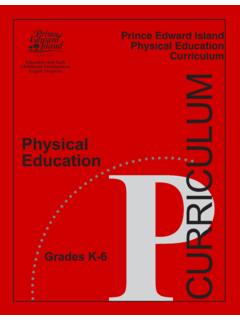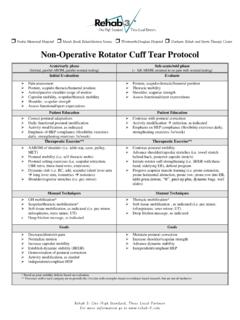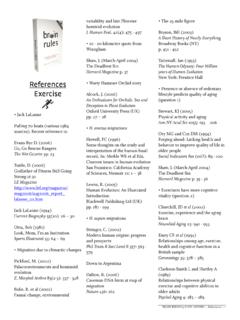Transcription of Courtesy of Deborah Tannehill - Jones & Bartlett Learning
1 GuidinG questions1. What is a curriculum?2. What is a standards-based curriculum?3. How does a standards-based curriculum differ from a traditional curriculum?4. Why have we gone to using a standards-based curriculum?5. How has educational reform impacted schools and the way they do business?6. What other factors have influenced curriculum development?7. How does planning differ with traditional and standards-based curricula?8. What role does assessment play in a standards-based curriculum?9. How are activities selected in a standards-based curriculum? Courtesy of Deborah 43/31/2014 1:35:25 PMIntroduction to Standards-Based Curriculum DevelopmentJacalyn Lund, Georgia State UniversityDeborah Tannehill , University of LimerickWhat makes a good program good? What are its main characteristics?
2 First, it is clear that a good program accomplishes something .. physical education must accomplish tangible outcomes to gain acceptance by students, faculty, administrators, and does your physical education program stand for? Can you articulate clearly what your program is attempting to accomplish? Can you communicate this to students, parents, and administrators? Could you produce tangible evidence that this is happening? physical education programs today are repeatedly being required to answer these and other questions. Educational reform and the move to standards-based education are changing the way educators do the graduate of your physical education program how would you want this person to act? What would you want them to know and be able to do? Many physical educators would reply that they want their graduates to choose to participate in physical activity, have sufficient skill and knowledge to do so successfully, and lead an active lifestyle.
3 Others may be more con-cerned with their students gaining social responsibility as they participate in a physically active lifestyle, and still others may focus on young people becoming physically active citizens who are 1 Reproduced from Siedentop, D., Mand, C., & Taggart, A. (1986). physical education: teaching and curriculum strategies for grades 5 12, p. 311, The McGraw-Hill Companies, Inc. 53/31/2014 1:35:25 PMconscious of the inequalities that exist for physical activity participation in some social contexts and work as change agents to remedy this situation. Though there is not just one correct answer, most likely all physical educators would want graduates to recognize that an active lifestyle con-tributes to physical health, as well as social and mental well-being.
4 Participation can manifest itself in a wide variety of forms from square dancing with a local group, to playing softball with a recreational team, to hiking in state or national parks. Although certainly a goal of most physical education teachers, having graduates participate in physical activity on a regular basis is not an automatic outcome of a physical education program, as our national health statistics confirm (Burgeson, Wechsler, Brener, Young, & Spain, 2003). Choosing to be physically active is the result of experiencing a solid curriculum that allows students to develop the skills and knowledge necessary for success, along with making them aware of activity venues within the community in which to participate (Rink, 2000). People tend to participate in activities during which they experience success.
5 The challenge for physical educators is twofold: first, to give students the skills and knowledge they need to be successful, and second, to introduce them to activity venues where they can participate in these activities long after they graduate from high stated previously, educational reform is changing the way schools operate. The move toward standards-based education is an attempt to clarify what schools and teachers are trying to accomplish. This book is designed to help you during the journey of developing a standards-based physical education program. Because knowing where to start is often the most difficult part, this chapter is designed to help you begin by defining what a curriculum includes, describ-ing how the standards-based movement began, and explaining the significance of this move-ment so that you will know the important components of developing a quality, standards-based physical education Is Curriculum?
6 Curriculum includes all knowledge, skills, and Learning experiences provided to students within the school program. This encompasses even those activities that are typically offered beyond the school day such as band, student clubs, intramurals, and after school sports teams. From our perspective, curriculum includes the planned and sequenced Learning experiences that allow stu-dents to reach significant goals deemed worthwhile for students to achieve. Ultimately, a curric-ulum represents the plan that guides delivery of Learning experiences and instruction. Although it is difficult to separate instruction from the curriculum and assessment, we will attempt to do so to better clarify the latter pieces of the triad. In this text, we will narrow our description of curriculum development to include only those experiences that are delivered within the physical education class typically offered within the school day, although we recognize that the curricu-lum actually includes much more than writing is the process of developing a sequence of activities and/or selecting an appropriate curriculum model that will enable students to meet curriculum Includes all knowledge, skills, and Learning experiences that are provided to students within the school Chapter 1 Introduction to Standards-Based Curriculum 63/31/2014 1:35:25 PMdesired goals at the conclusion of their school experience.
7 The curriculum outlines the big picture for this process; develops assessments that are given at various points, allowing stu-dents to demonstrate success toward meeting these goals; and identifies activities that allow graduates to meet curricular goals. In the past, curricular goals were determined largely by the school district developing the curriculum. Most school districts relied on teachers within the system to write the curricular goals. Educational reform has now provided external guidelines that schools are required to follow. States and nations have developed standards, which are statements describing what students should know and be able to do. Instead of developing their own goals, most teachers are now required to have their students meet standards at the state, district, or national level.
8 How the standards are unpacked will result in programs looking quite different depending on the decisions made about the content and the activities used to meet the Is a Standards-Based Curriculum?A standards-based curriculum represents a huge paradigm shift for many teachers currently in the field (Doolittle, 2003). In the past, choice of activ-ity led the design of the curriculum. Curricula were written to include a variety of activities tradi-tionally included in a physical education program. The focus was on developing skill competence for students in these sports or activities. In other words, teachers taught students the skills necessary to play volleyball, soccer, or tennis; dance; or swim, for example, and the only goal was for stu-dents to be able to play or perform the activity.
9 Activities were selected because they were typically played by one gender or the other ( , boys wrestled and girls danced), were commonly played in a certain region ( , ice hockey was common in Minnesota physi-cal education programs), teachers were competent performers in the sport or activity and/or they enjoyed teaching the unit, or that was tradition certain sports have always been included in physical education and not including them would almost be an act of heresy ( , basketball). As new sports or activities emerged they might be included in the cur-riculum if facilities, equipment, and personnel were available ( , inline skating, ulti-mate, team handball, etc.). Other activities might be eliminated for a variety of reasons ( , trampoline units were eliminated largely for liability reasons).
10 Developing a standards-based curriculum begins by looking at the standards; recognizing the skills, knowledge, and dispositions that students should demonstrate to meet these standards; and selecting a curriculum model and/or activities that will allow students to reach the outcomes standards Curriculum goals established at the national, state, or district level that identify the skills, knowledge, and dispositions that students should curriculum A curriculum that is developed by looking at the standards (district, state, or national); identifying the skills, knowledge, and dispositions that students should demonstrate to meet these standards; and identifying activities that will allow students to reach the goals stated in the standards. What Is a Standards-Based Curriculum? 73/31/2014 1:35:25 PMstated in the standards.















